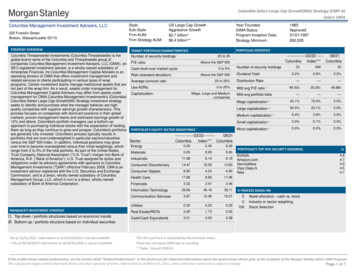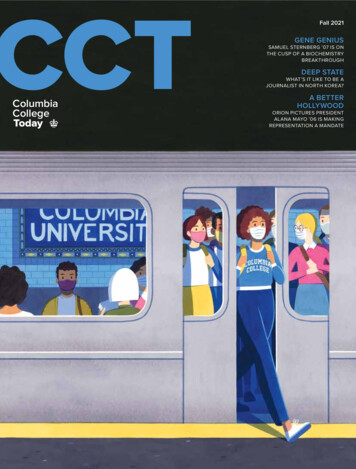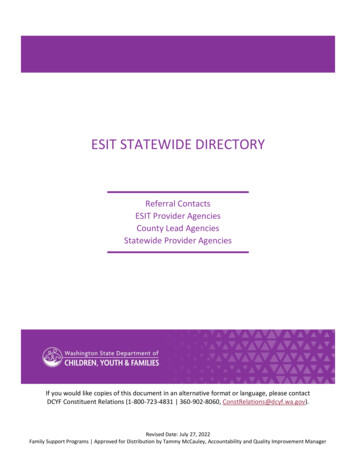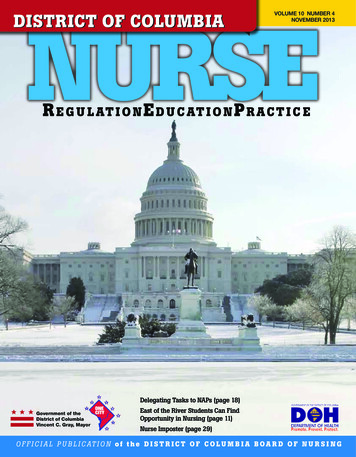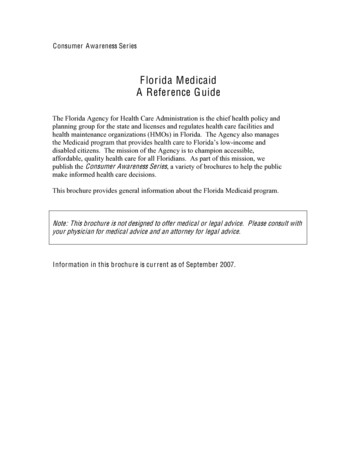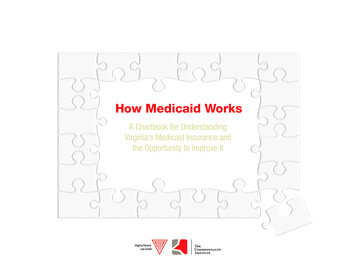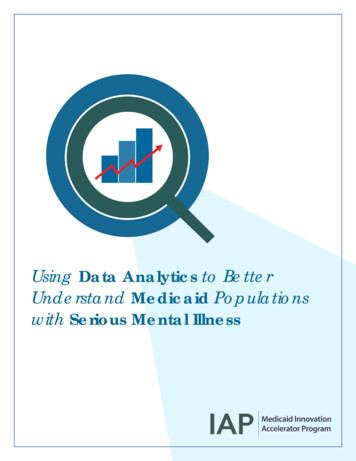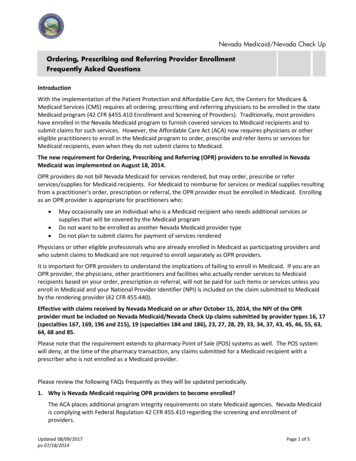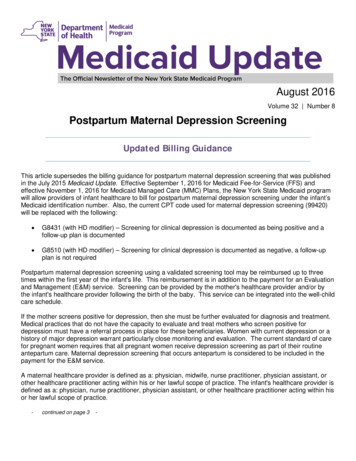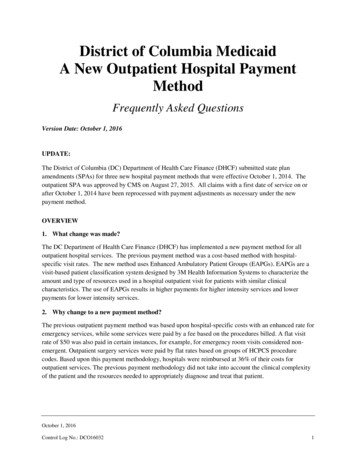
Transcription
District of Columbia MedicaidA New Outpatient Hospital PaymentMethodFrequently Asked QuestionsVersion Date: October 1, 2016UPDATE:The District of Columbia (DC) Department of Health Care Finance (DHCF) submitted state planamendments (SPAs) for three new hospital payment methods that were effective October 1, 2014. Theoutpatient SPA was approved by CMS on August 27, 2015. All claims with a first date of service on orafter October 1, 2014 have been reprocessed with payment adjustments as necessary under the newpayment method.OVERVIEW1. What change was made?The DC Department of Health Care Finance (DHCF) has implemented a new payment method for alloutpatient hospital services. The previous payment method was a cost-based method with hospitalspecific visit rates. The new method uses Enhanced Ambulatory Patient Groups (EAPGs). EAPGs are avisit-based patient classification system designed by 3M Health Information Systems to characterize theamount and type of resources used in a hospital outpatient visit for patients with similar clinicalcharacteristics. The use of EAPGs results in higher payments for higher intensity services and lowerpayments for lower intensity services.2. Why change to a new payment method?The previous outpatient payment method was based upon hospital-specific costs with an enhanced rate foremergency services, while some services were paid by a fee based on the procedures billed. A flat visitrate of 50 was also paid in certain instances, for example, for emergency room visits considered nonemergent. Outpatient surgery services were paid by flat rates based on groups of HCPCS procedurecodes. Based upon this payment methodology, hospitals were reimbursed at 36% of their costs foroutpatient services. The previous payment methodology did not take into account the clinical complexityof the patient and the resources needed to appropriately diagnose and treat that patient.October 1, 2016Control Log No.: DCO160321
DC Medicaid EAPG FAQ3. What are the goals that DHCF hopes to achieve by implementing a new outpatient paymentmethodology?Goals of the new outpatient hospital payment method include: Implement a sustainable payment method. The District needs an outpatient payment method that issustainable over time, promotes quality of care and is flexible enough to accommodate changes inpayment policy and federal regulatory requirements. Increase fairness. Under the previous payment method, different hospitals were often paid verydifferent amounts for the same or very similar care to similar patients based upon historic differencesin the cost of providing care. We believe it is fairer to have payment reflect resources currentlyavailable and the reasonable costs of providing care based on patient needs rather than the individualhospital’s historic experience in providing care. Reduce administrative burden. One component of the previous payment method relied on diagnosiscodes defined as emergent for an add-on ER payment. Maintaining this list of emergent diagnosiscodes presents an administrative burden after implementation of ICD-10 coding. The EAPG grouperis compliant with ICD-10 coding. Improve purchasing clarity. Under the previous payment method, it was very difficult to understandhow much Medicaid was paying for specific types of outpatient services. The District aimed to alignits payment methodology with prevailing methodologies used by other Medicaid programs andprivate payers that improve purchasing clarity and encourage hospital efficiency.4. Does the implementation of ICD-10 impact the new payment method?The EAPG grouper is fully compliant with both ICD-9 and ICD-10 codes.5. What providers and services are affected?The new payment method will apply to all outpatient hospital services provided by: In-District general acute care hospitals and specialty hospitals that offer outpatient hospital services(psychiatric, rehabilitation, and children’s hospitals) and Out-of-District hospitals, except for Maryland hospitals.ENHANCED AMBULATORY PATIENT GROUPS (EAPGS)6. Why were EAPGs chosen? Why not the Ambulatory Payment Classification groups (APCs)that Medicare uses?The District conducted an assessment of various options available for payment of outpatient hospitalservices, including Medicare’s APCs. EAPGs were chosen because they are more suitable for use withthe Medicaid population. Medicare APCs were designed for the Medicare population in support ofMedicare policies. EAPGs are designed for an all-patient population. EAPGs reflect the relative intensityof the entire visit allowing providers and payers to more accurately account for resources and forOctober 1, 2016Control Log No.: DCO160322
DC Medicaid EAPG FAQpayment. EAPGs reward hospitals for providing efficient access to a wide variety of increasinglyclinically complex outpatient hospital services in a more appropriate manner.As opposed to Medicare’s APC mixed fee schedule approach, EAPGs are an outpatient visit groupingsystem, which places patients and services into clinically coherent groups. EAPGs do rely on theCPT/HCPCS procedure code but also use diagnosis codes and other clinical and demographic factors todetermine appropriate EAPG assignment. And while APCs generate payment based on volume of codessubmitted, EAPGs are more clinically driven and are designed to generate payments that reflect therelative resource intensity of the entire visit. Therefore the use of EAPGs will result in higher paymentsfor higher intensity services and lower payments for lower intensity services.7. In general, how will the new payment method impact hospitals?In general, the new payment method provides rational incentives for the provision of outpatient hospitalservices: There is a more direct link between the level of payment and the complexity of the service provided.Efficiency and cost containment are rewarded. Hospitals that provide similar services are paidsimilarly. Complete and correct coding of claims is more important, and may have an effect on claim payment.It should be noted that CPT/HCPCS codes are not required nor expected on every line of the claim.Some claim lines may be bundled whether or not a procedure code is present. Hospitals should codeclaims according to national coding guidelines.8. What other payers use EAPGs?Medicaid programs currently using EAPGs include: New York, Virginia, Wisconsin, Illinois andWashington, DC for payment; and Massachusetts for service-mix adjustment. Medicaid programs withplanned EAPG implementations for outpatient hospital services are: Ohio, Nebraska, Florida, Colorado,and Texas. Massachusetts will begin using EAPGs for payment beginning December 1, 2016.Commercial payers currently using EAPGs include: Oklahoma BlueCross BlueShield, MinnesotaBlueCross BlueShield, and Wellmark in Iowa and South Dakota. BlueCross BlueShield of Alabama willmove to EAPGs effective October 1, 2016.9. Is my hospital required to purchase EAPG software in order to receive payment under the newmethod?No. The EAPG grouper/pricer specific to DC Medicaid assigns the EAPGs to the claim lines andcalculates the payment. The DC Medicaid claims processing system then adjudicates the claim for finalpricing. Hospitals may choose to purchase grouping software allowing them to project revenue. ForWashington, DC, the 3M sales representative is Kelli Boswell, Client Relationship Executive, 770-7252090. Neither DHCF nor Xerox has a financial interest in any 3M product.10. Does my hospital have to start collecting additional data to use 3M EAPGs?No. The data elements needed for EAPG grouping include only those that hospitals already submit on thepaper and electronic standard institutional claim forms. For example, diagnosis codes, CPT/HCPCSOctober 1, 2016Control Log No.: DCO160323
DC Medicaid EAPG FAQprocedure codes, revenue codes, line item dates of service, age and gender. Hospitals do not need to addthe EAPG to the claim. The EAPG grouper in the DC claims processing system assigns the EAPG.PAYMENT CALCULATIONS11. How is EAPG payment calculated?Each CPT/HCPCS procedure code on a claim line is assigned to the appropriate EAPG at the line level.Each EAPG has an assigned relative weight. This relative weight is adjusted by the various paymentmechanisms as applicable such as discounting, packaging and consolidation. The adjusted relative weightis multiplied by a conversion factor to yield the EAPG payment amount. DC Medicaid has also added a50% pediatric policy adjustor for FY 17 (this is unchanged from FY16). This is applied as a percentincrease on claims for beneficiaries under the age of 21.Table 1EAPG PaymentEAPG payment (Adjusted EAPG relative weight * pediatric policy adjustor) * conversion factorAdjusted EAPG relative weight EAPG relative weight *multiple significant procedure discount * bilateralprocedure discount * terminated procedure discount * repeat ancillary procedure discount * other discounts12. What EAPG relative weights are used to calculate EAPG payment?DC Medicaid currently uses version 3.8 of the national relative weights available from 3M HealthInformation Systems. The EAPG national relative weights are calculated by 3M based on Medicareclaims data, comprising approximately 55 million claims from FY 2014. Effective October 1, 2016, DCMedicaid will move to version 3.11 of the 3M EAPG national relative weights.During the design of the new outpatient payment method, DHCF did examine other options for relativeweights. After review, the District opted to use the national relative weights because statistically validDistrict-specific relative weights are not feasible due to the District’s small volume of Medicaid claims.The national relative weights are updated annually by 3M and use EAPG default settings which alignmore closely with the District’s overall approach and goals. Other Medicaid programs also use or plan touse the national relative weights for their EAPG-based payment method.13. What conversion factors are used in EAPG payment?For both FY 2016 and FY 2017, DHCF uses three conversion factors: one for in-District and out-ofDistrict hospitals and one that is 2% higher for United Medical Center (based on its geographic locationin an economic disadvantage zone). National Rehabilitation Hospital also has a separate conversionfactor because of their significantly different cost structure and more limited array of outpatient servicesthan that of the other hospitals. The values for the final conversion factors effective for Fiscal Year 2016(October 1, 2015 through September 30, 2016) and Fiscal Year 2017 (October 1, 2016 through September30, 2017) are shown in the table below.October 1, 2016Control Log No.: DCO160324
DC Medicaid EAPG FAQConversion FactorsFY 2017FY 2016National Rehab Hospital 150.80 205.32United Medical Center 664.18 692.34All Other Hospitals 651.16 678.7614. How were conversion factors calculated?For both FY 2016 and FY 2017, the conversion factors were configured to achieve overall paymentsequal to 77% of inflated costs. FY16 costs were estimated using cost-to-charge ratios (CCRs) from theDistrict’s FY 2014 (October 1, 2013-September 30, 2014) hospital cost reports which were inflatedforward to FY15 by a 2.52% inflation factor. FY17 costs were estimated using CCRs from the District’sFY 2015 (October 1, 2014 through September 30, 2015) hospital cost reports which were inflated forwardto FY16 by a 3.3% inflation factor. For FY16, the budget target was reduced by 5% with the expectationthat hospitals will improve coding above 77% of inflated costs. No coding improvement factor wasapplied to FY17 simulations.While conversion factors for FY17 are lower than the FY16 conversion factors, this change does notrepresent a decrease in overall payment rates. The District is moving from version 3.8 of the EAPGnational weights to version 3.11. The overall impact of that change on DC claims was an increase inaverage claim service mix. In other words, the relative weights of the EAPGs used in DC increased byabout 17% from version 3.8 to version 3.11. In order to maintain the District’s budget target of a 77%pay-to-cost ratio, conversion factors had to be lowered.15. How often will conversion factors be updated?DHCF will evaluate rates on an annual basis to consider any changes necessary to conversion factorsbased on budgetary constraints and other factors. DHCF will monitor payment levels closely, especiallyduring the first year of EAPG payment to ensure that payments do not grossly differ from budgetedamounts.16. What version of the EAPG grouper was implemented?Effective October 1, 2014, DHCF implemented version 3.8 of the EAPG grouper, which was released inJanuary 2013. For October 1, 2016, DHCF will implement version 3.11 which was released in January2016.17. Will there be regular updates to the EAPG Grouper/Pricer software?Yes. DHCF performs EAPG quarterly updates, which generally involve staying current withCPT/HCPCS coding updates. The grouper version will be updated at a minimum every two years, whichmay involve changes in grouper logic, enhancements and updates to EAPG settings.October 1, 2016Control Log No.: DCO160325
DC Medicaid EAPG FAQ18. Will any outpatient hospital services be paid based on a fee schedule under EAPGs?No. All outpatient hospital services are paid based on EAPGs. No services have been identified forpayment by fee schedule at this time.19. Will outlier payments be included in the new payment method?Outlier payment provisions are typically made for cases that are unpredictably expensive. The District’sanalysis of claims data performed to date does not indicate extreme variation in claim charges or cost,typically associated with outlier cases. An outpatient cost outlier payment policy is not used unless a needis identified in future claims data analyses.20. Is EAPG payment capped to the lower of the EAPG payment or billed charges?The previous outpatient hospital payment method limited payment for some services to the lesser of thecalculated amount or billed charges. Limiting payment to billed charges is typically used to control costs,particularly when the payment method is based on a percent of charges. EAPGs are a visit-based patientclassification system designed to link the level of payment with the complexity of the service provided.When a sophisticated grouping algorithm is used to price claims, such as EAPGs, the result is that ahospital may be paid more than its charge on a specific claim or line and significantly less than its chargefor others due to payment bundling techniques (packaged services and discounting). However, on balancethe payment method is expected to be fair. A charge cap to limit payment to billed charges is notimposed.21. Does this change affect payments from Medicaid managed care plans?While payments to hospitals from Medicaid managed care plans are outside the scope of this project, theDC Medicaid managed care organizations may opt to move to Medicaid’s new fee-for-service paymentmethods.22. Does the change affect how Medicare crossover claims are paid?No. The payment logic for Medicare crossover claims is not affected by EAPGs. DC Medicaid continuesto pay the lesser of these two amounts on an outpatient crossover claim:a. The Medicaid allowed amount minus the Medicare paid amountb. The Medicare co-insurance amount plus Medicare deductible amountCOVERAGE AND PAYMENT FOR SPECIFIC SERVICES23. What changes, if any, were made to prior authorization policy?The Department uses prior authorization to help control inappropriate utilization of services. While therewere no changes specifically related to the implementation of EAPGs, changes in the Department’s priorauthorization policy are made from time to time to address new coverage policies, new technologies or toaddress areas of potential fraud, waste and abuse.October 1, 2016Control Log No.: DCO160326
DC Medicaid EAPG FAQ24. How are laboratory and radiology services paid?Laboratory and radiology services are processed and paid by EAPG, subject to consolidation, packagingor discounting as applicable.25. How are physical, occupational, and speech therapy services paid?Physical therapy, occupational therapy and speech therapy procedures are processed and paid by EAPGs,subject to consolidation, discounting and packaging as applicable.26. How are dental services provided in an outpatient hospital setting paid?Outpatient hospital dental services are processed and paid by EAPGs. The procedure codes and paymentare for the facility services, not for the professional services provided by the dentist. Professional servicesprovided by dentists (e.g., pediodentist) are not included in the EAPG payment method and will continueto be billed separately and paid by fee schedule.27. How are payments for pediatric services affected under EAPGs?For FY 2016, a 50% pediatric policy adjustor applies to claims for beneficiaries under the age of 21. Thismeans that payments for these claims will be 50% higher than the otherwise calculated EAPG payment.For FY 2017, the pediatric policy adjustor will remain at 50%. See FAQ #11 for an illustration of thecalculation formula.28. Are payments for vaccines and vaccine administration codes affected?DHCF continues its existing policy and makes no payment for vaccines available through the Vaccinesfor Children (VFC) Program. VFC vaccines are not payable under Medicaid because these vaccines arefederally funded and available at no charge to providers for Medicaid eligible children.Other vaccine and vaccine administration procedure codes currently covered for adults and children areprocessed through the EAPG grouper. The payment for vaccine administration codes for adults andchildren are bundled when a significant procedure is billed on the claim.29. What changes were made to observation room services policy?DHCF changed its previous policy and now pays separately for observation room services under certainspecific conditions. Observation room services begin at the time that the physician writes the order toevaluate the patient. The new DHCF policy states that observation services must be at least 8 hours and not more than 48hours.Payment for observation services is based on the EAPG, regardless of the number of units (hours)billed as long as units billed are at least 8. If units are not at least 8, the line will group to EAPG 999and pay zero.Observation room services are always packaged when a significant procedure is also billed.October 1, 2016Control Log No.: DCO160327
DC Medicaid EAPG FAQUnder the new payment method, observation room services may be identified by HCPCS code G0378which groups to EAPG 450. The relative weight for this EAPG reflects the national average units (hours)greater than 8. (For details on the observation logic, please see EAPG Information handout question #11)30. What changes were made to partial hospitalization program (PHP) services policy?No change in current policy for partial hospitalization program (PHP) services was made due to the newpayment method. Consistent with the District Medicaid State Plan, PHP services are not a coveredoutpatient hospital service, except as part of waiver services. PHP services are not paid under the newpayment method based on EAPGs.BILLING AND EDITING31. What billing practices are important for hospitals to follow under EAPGs?The EAPG grouper relies on procedure and diagnosis codes and patient demographic information toaccurately group and price claims. Hospitals are asked to ensure that these fields are coded completely,accurately and defensibly on their outpatient claims based on national coding guidelines.32. Do hospitals have to submit claim lines in any particular order under EAPGs?No. After EAPGs were activated in the claims processing system, the order in which claim lines orHCPCS procedures are billed on the claim is not relevant for accurate payment. Under certaincircumstances, such as when multiple unrelated significant procedures are billed in the same visit, thegrouper ranks those procedures by weight for discounting purposes. This occurs regardless of the order inwhich lines are billed on the claim.33. Do hospitals need to continue using the DC Medicaid visit codes?Under the previous payment method, hospitals were required to bill outpatient hospital services using oneof the District-designated ‘visit codes’ which included mostly evaluation and management CPT codes.The presence of the visit codes did not interfere with accurate payment of the claims when they werereprocessed under EAPGs. Now that EAPGs are activated in the DC Medicaid system, hospitals nolonger have to use the visit codes in order to receive claim payment.34. When should outpatient services be billed as part of an inpatient claim?Hospital outpatient diagnostic services provided one to three days prior to an inpatient admission at thesame hospital are not separately payable and should be billed as part of the inpatient stay. Diagnosticservices are defined by revenue code, see table below. All hospital outpatient services (regardless ofrevenue code) that occur on the same day as an inpatient admission at the same hospital are alsoconsidered part of the inpatient stay and as such are not separately payable.October 1, 2016Control Log No.: DCO160328
DC Medicaid EAPG FAQDiagnosticRevenue Codesfor 3-DayWindowRevenue Code Desc0254 - 0255Pharmacy0341, 0343Nuclear medicine0371 - 0372Anesthesia0471Diagnostic audiology0482 - 0483Cardiology0918Behavioral health svcs0300 - 0319Laboratory0320 - 0329Diagnostic radiology0350 - 0359CT Scan0400 - 0409Other imaging0460 - 0469Pulmonary function0530 - 0539Osteopathic svcs0610 - 0619Magnetic resonance tech0621 - 0624Med/surg supplies0730 - 0739EKG/ECG0740EEG0920 - 0929Other dx services35. Is there any limit to the number of diagnosis codes, modifiers, CPT or procedures codes thatcan be submitted per claim?The DC claims processing system can accept up to 26 diagnosis codes; however the EAPG grouper onlylooks at the principal diagnosis and does so only under certain circumstances. The limit on the number oflines per claim that can be accepted by the EAPG grouper is 450. Up to four modifiers may be acceptedper line but only certain modifiers impact payment under EAPGs, please see FAQ #44.36. Should HCPCS/CPT procedure codes be billed on every line of the outpatient claim?No. HCPCS/CPT codes are not expected on some claim lines, such as certain drugs and supplies. Whilelines without procedure codes are assigned to EAPG 999 with zero payment, the payment for these itemsis included in the payment for the significant procedure or medical visit. Some claim lines are packagedor consolidated even if a procedure code is present. Hospitals should note that there is a list of specificrevenue codes for which DC Medicaid requires a procedure code. This list is not new nor does it changeunder EAPGs.October 1, 2016Control Log No.: DCO160329
DC Medicaid EAPG FAQ37. How do the National Correct Coding Initiative edits apply under the new payment method?DHCF continues to identify and edit claims where coding methods do not adhere to these federalguidelines under the new EAPG payment method. The National Correct Coding Initiative is a federalrequirement for all Medicaid programs under the Affordable Healthcare Act.38. How are payments for professional revenue codes affected?Effective October 1, 2014, professional fees revenue codes are not eligible for payment under the EAPGpayment method when billed on outpatient hospital claims (UB-04). These professional services shouldcontinue to be billed on professional claims (CMS-1500).39. What type of bill (TOB) should be used for billing outpatient hospital surgery services?Under the previous payment method, hospitals were required to use bill types 0830-0838 to bill foroutpatient hospital surgery services and some chemotherapy services. Now that EAPGs are activated inthe DC Medicaid claims processing system, outpatient surgical services should no longer be billed withbill types 0830-0838 because these bill types are designated for ambulatory surgery centers. Outpatienthospital services should be billed with bill types 0130-0138.40. How is an outpatient hospital visit defined under EAPGs?Under EAPGs, an outpatient hospital visit is defined as services on a single claim billed with the samedate of service. A given claim may contain multiple visits if the dates of service are different. However,a single visit cannot cross different claims.The ability to recognize multiple visits for payment on a single claim is a functionality that is built intothe EAPG grouper software. Under the previous payment method, multiple dates of service on a singleclaim were not recognized for separate payment. Under EAPGs, each date of service on a claim isprocessed and paid as a separate visit.41. How are medical visits paid under EAPGs?Lines billed with HCPCS/CPT codes that are designated by the EAPG grouper as a medical visit indicatorEAPGs are packaged in the presence of a significant procedure. If a claim is billed with a medical visitHCPCS/CPT code and no significant procedure is present, then the EAPG for that line is assigned basedon the principal diagnosis. Most of the HCPCS/CPT codes designated as medical visit indicator codes areevaluation and management codes.42. Has DC Medicaid implemented an inpatient-only list? Is the list the same as that maintained byMedicare for APCs?Yes. The EAPG list of inpatient-only services applies under the new payment method. The list ofprocedures is similar but less restrictive than the Medicare list.43. What bundling or packaging methods did DHCF implement with EAPGs?October 1, 2016Control Log No.: DCO1603210
DC Medicaid EAPG FAQBundling or packaging refers to grouping different services provided into a single payment unit. Abundled or packaged service receives no separate payment. DHCF will implement the following bundlingmethods with EAPG payment:Packaging/BundlingDescription Packaged Services Significant Procedure Consolidation Discounting Multiple SignificantProcedures Discounting Repeat Ancillary/Drug/DMEProcedures A standard list of packaged EAPGs is built into the grouper.Packaging occurs in the presence of significant procedure visits or medicalvisits.Packaging applies only to procedures that group to ancillary, drug and DMEEAPGs.If a significant procedure or medical visit is not present on the visit, items on thestandard packaging list may be paid separately.Consolidation refers to the collapsing of significant procedures into a singleEAPG - when one significant procedure is performed, additional significantprocedures may require minimal additional time or resources.The procedures are ranked based on the relative weight of the EAPG.There are two types: Same significant procedure, which applies to procedures that group to thesame EAPG. Clinically related significant procedure, which applies to related EAPGs.This type of discounting refers to a reduction in the payment for an EAPG –when an unrelated significant procedure is performed multiple times during thesame visit.Multiple significant procedure discounting is applied to procedures within thesame EAPG type and across EAPG types.The procedures are ranked based on the relative weight of the EAPG.Discounting level percentages are applied: 100, 50 and 25 percent for the first,second, third and subsequent procedures.This type of discounting refers to a reduction in the payment for an EAPG –when non-routine ancillary procedures are repeated on the same visit.Discounting is applied to repeat procedures for ancillary, drug and DMEprocedures within the same EAPG.Discounting level percentages are applied: 100 percent for the first non-routineancillary, 50 for the first repeated ancillary and 25 percent for the second, thirdand subsequent repeated non-packaged procedures, respectively.Notes:1. There are six EAPG significant procedure types subject to consolidation and discounting: significant procedure, physicaltherapy and rehabilitation, mental health and counseling, dental procedure, radiologic procedure, and other diagnosticprocedure.2. 3M Health Information Systems, Definitions Manual, Version 3.11.16.1, January 201644. What modifiers impact payment under EAPGs?The EAPG grouper recognizes a number of modifiers which may potentially impact payment. Somemodifiers are used to increase or decrease the payment amount. Some modifiers are informational andwill not affect payment. Hospitals should continue to use standard coding conventions in the assignmentof modifiers.October 1, 2016Control Log No.: DCO1603211
DC Medicaid EAPG FAQModifierDescriptionEffect on EAPG PaymentTherapy modifiers GN (speech andlanguage), GO (occupational), GP(physical) Identify whether the therapy services werefor speech, occupational or physical therapyservices.Used to report procedures performed onAnatomical modifiers and other selectpaired organs or specific sides of the body, modifiers (E1–E4, F1–F9, FA, LT, RT T1– (e.g., eyelids, fingers, toes, arteries, kidneys,T9, TA, 76, 77, RC, LC, LD, LM and RI) lungs, right, left) or to report the sameprocedure was performed more than onceby the same or different physicians.Claim lines billed with therapymodifiers will not be exemptfrom significant procedureconsolidation.Claim lines billed with thesemodifiers will not be exemptfrom significant procedureconsolidation.Modifier 25 Distinct serviceUsed to report significant, separatelyidentifiable evaluation and management (E/M) service by the same physician on thesame day as a significant procedure or otherservice.Medical visits are payable with asignificant procedure in thepresence of this modifier.Used to report multiple outpatient hospitalE/M and emergency room visits on thesame day to indicate that the E/M service isa separate and distinct E/M encounter. Modifier 27 Multiple outpatient hospitalE/M encountersLines billed with this modifiermay be p
As opposed to Medicare's APC mixed fee schedule approach, EAPGs are an outpatient visit grouping . New York, Virginia, Wisconsin, Illinois and . Effective October 1, 2016, DC Medicaid will move to version 3.11 of the 3M EAPG national relative weights. During the design of the new outpatient payment method, DHCF did examine other options .
